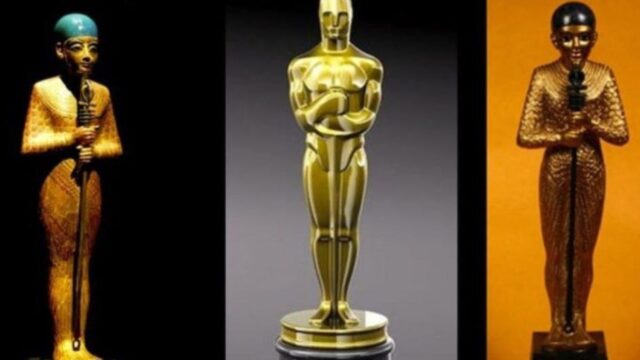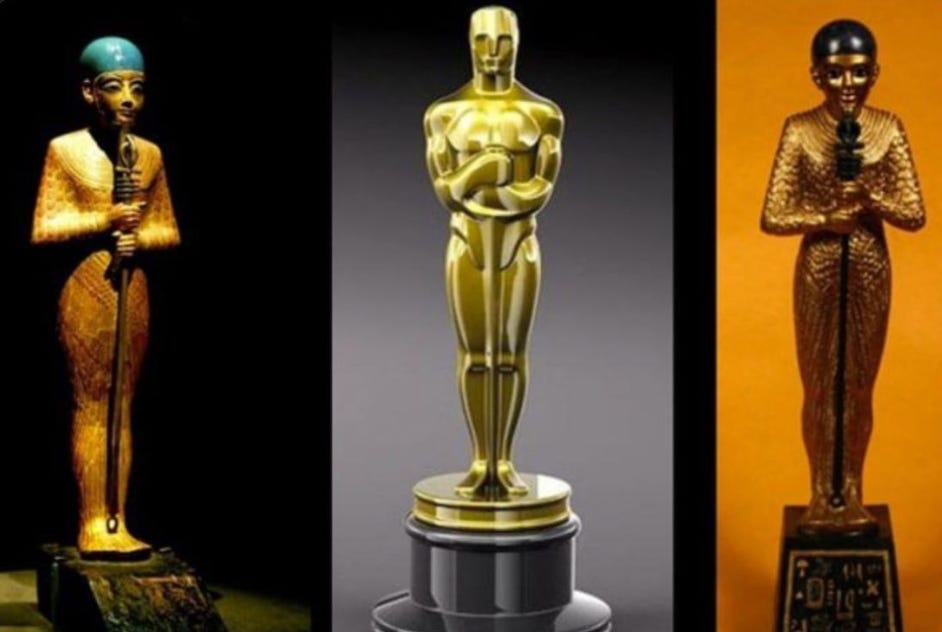The Golden Idol Machine

The anti-human nature of fame.
The other day, I found my high school yearbook. My kids were flipping through it, laughing at old photos and hairstyles, and one of them paused, surprised. “You and your friends were in all these clubs?” Debate, theater, student council, wrestling—page after page of awkward group photos and teenage optimism.
It made me smile. I hadn’t thought about that version of myself in a long time. I told them the truth: I joined everything, not because I had it all figured out, but because I didn’t. When you’re a kid, you need spaces like that—launching pads for connection, experiments in identity. Trying things on. Figuring out where you fit, and just as often, where you don’t.
These days, I’ve taken on more of the Groucho Marx philosophy—I’d never join a club that would have me as a member—but back then, those communities mattered. They were real. Messy. Human. They involved showing up, in person, with all your imperfections. There were no filters. No followers. No likes.
Most importantly, they weren’t content. We joined because we cared about the thing itself—the debate, the play, the game—and because we were hanging with friends who were actually there. Success wasn’t measured in views or engagement, but in whether you got better, whether you belonged, whether you contributed something real.
That’s what’s been on my mind lately: what it means to grow up in a world where being known has been untethered from being known by the people around you, where every human experience gets filtered through the question of whether it’s worth posting.
The Economic Engine of Performance
There is something deeply unnatural about being famous—or even semi-famous—outside the borders of your own community. Once, reputation was earned slowly, through presence and action. Now, you can be ‘known’ by millions who don’t actually know you at all.
I’ve watched this machine operate across different worlds. In tech, I saw smart friends get their faces on magazine covers and slowly transform into their own press releases. In the brewery business, I watched food industry people inflate their own importance, turning craft into performance, substance into brand. Most recently, in medical freedom activism, I’ve seen principled people get seduced by follower counts, optimizing for viral moments or proximity to power instead of genuine change.
The pattern is always the same: the work becomes secondary to the platform. Authenticity gets traded for amplification. And the person—the real person—disappears behind the persona.
Now I see the same thing happening to an entire generation. Young people today are choosing influencer culture over traditional paths—and I could sound like every generation before me complaining about “young people these days.” But here’s what I’ve come to understand through watching this across industries: they’re not choosing this path just because they’re shallow or narcissistic. They’re choosing it because we’ve made everything else economically impossible.
When housing costs have far outpaced wage growth, when traditional career paths no longer guarantee basic stability, when you can struggle to afford rent while doing meaningful work or potentially make real money by turning yourself into a brand—what would any rational person choose?
The traditional middle path has been systematically eliminated. You can join corporate America and surrender your soul to institutional conformity, or you can be a small business person and struggle financially while competing against algorithmic systems designed to favor monopolistic forces—working 80-hour weeks for what used to be a comfortable middle-class living, watching Amazon destroy your retail business or Google bury your website in search results. Influencing promises a third way—entrepreneurship without the overhead, creativity without corporate constraints, financial success without traditional gatekeepers. Of course, it’s a lie. You’re still surrendering to an algorithm, still conforming to platform demands, still subject to powers you can’t control. But when the other options feel impossible, the lie becomes irresistible. And it’s a road to nowhere—a few winners, millions of casualties, and an entire generation taught that their value lies in their ability to perform rather than create, to influence rather than contribute, to be seen rather than to matter.
We’ve created an economy where selling yourself is more profitable than making something of value. The American dream of homeownership, stable work, and raising a family has become so financially out of reach that “become an influencer” represents one of the few remaining paths to economic security.
And the tragic irony is that even those who “succeed” in this system often find themselves isolated. I’ve watched friends and acquaintances who became influencers grow paranoid about every relationship, unable to tell if people genuinely like them or just want access to their platform. The very system that promises connection destroys their ability to trust authentic human bonds.
This economic trap doesn’t just limit choices—it severs something deeper, leaving us grasping for meaning in a world that’s lost its natural rhythm.
And girls, especially, are pushed into this with terrifying precision. The message is everywhere: your power lies in your image, your value in your sexuality, your success in monetizing both. It’s not subtle. It’s a pipeline—Instagram to influencer to OnlyFans—that platforms systematically engineer. OnlyFans scouts actively recruit from Instagram’s most popular creators, while algorithms reward increasingly sexualized content with greater reach and visibility. As recent research documents, the platform’s design encourages ‘upskilling’ in sexualized content, making financial success directly tied to intimate performance. What The Washington Post calls ‘the creator economy at its most transactional’ has turned young women’s bodies into monetizable units. It’s devastating. Not just economically, not just emotionally, but spiritually.
The Deeper Disconnection
But there’s something even more fundamental at work here. What if this desperate seeking for external validation represents something deeper—the symptom of a species that’s lost its natural guidance system? Julian Jaynes theorized that humans once received direct coordination through what he called the bicameral mind—a state where people heard guiding voices they experienced as gods. But I wonder if our ancestors weren’t actually hearing random hallucinations but were basically human antennas picking up electromagnetic signals from the sun and moon that told them when to plant, harvest, and coordinate as a society.
The ancient Egyptians understood this system perfectly. They had Ptah, the creator god who brought reality into being through pure spoken command—not through physical action, but through divine voice alone. Ptah represented the ultimate cosmic command center, the source of coordinating guidance that aligned civilization with natural cycles. Now we have Oscar statues—golden idols that honor people who pretend to be other people. Where Ptah once commanded when to plant and harvest, today’s celebrities command what to wear, how to think, who to be. Young people don’t just watch them; they follow their lifestyle guidance as if it were divine instruction. We’ve gone from divine coordination to celebrity performance, from cosmic guidance to consumer programming.

This lost connection explains why artificial guidance feels so addictive. Social media algorithms mimic the rhythm of natural coordination—the constant feedback, the sense of collective movement, the feeling that you’re part of something larger. But instead of planting season or harvest time, the algorithm tells you when to post, what to buy, how to look. We’ve replaced cosmic rhythm with engagement metrics, seasonal cycles with content calendars. The influencer becomes the high priest of this broken system, translating digital signals into human behavior, promising connection while delivering only performance.
The Century-Long Pattern
This disconnection didn’t happen overnight. As I’ve documented in Engineering Reality, a comprehensive three-part series I published last winter, the mechanisms we see today were built over more than a century, evolving from physical monopolies to psychological manipulation to digital automation. What that research revealed was that celebrity culture itself was systematically created by intelligence operations and corporate interests. The British Invasion, the counterculture movements, the entire apparatus of modern fame—these weren’t organic developments but carefully orchestrated operations designed to redirect authentic human impulses into controllable, profitable channels. Readers interested in the full historical scope of these systems can explore that deeper analysis.
The seeds were planted generations ago—kids in the 1950s idolized Mickey Mantle and Little Richard, I grew up loving Don Mattingly and Neil Young. There’s nothing wrong with admiring excellence or achievement. But there’s a difference between respecting someone’s craft and unhealthy obsession. Now we live in an era where TikTok influencers who dance for thirty seconds make more than teachers, nurses, or the engineers who build our bridges. We’ve moved from celebrating skill to monetizing attention, from honoring achievement to rewarding performance and exhibitionism.
This is the era of the parasocial bond, a one-way intimacy where strangers form connections with a curated version of a person. As Jasun Horsley has extensively documented, parasocialism represents the systematic hijacking of communal relations through technological media, creating childish dependency on public figures while severing our connection to local community. Instead of quiet growth, kids are nudged toward public performance. Instead of mentorship, they get metrics. Instead of community, they get platforms. We’ve replaced becoming with branding, character with clout.
The same forces that redirected authentic counterculture movements into profitable products now channel kids’ natural desire for meaning into the influencer pipeline. Celebrity culture emerged alongside the mass media of the 20th century, offering centralized command that millions could receive simultaneously.
We used to look to divine figures for cosmic guidance. Now we look to golden statues that celebrate entertainment over wisdom. We’ve gone from divine command to celebrity performance, from cosmic coordination to consumer manipulation.
The Kardashians aren’t admired for integrity or substance, but for visibility. They are what happens when the self becomes the product—when every gesture, curve, and crisis is commodified. They aren’t people. They’re portfolios. And we hold this up to kids as something to aspire to?
The Surveillance Breeding Ground
This transformation becomes even more sinister when you understand how it intersects with the surveillance apparatus. As I’ve written about before in examining how we’ve created a culture of self-censorship, this surveillance apparatus breeds the very behavior that fame culture exploits—the desperate need to control your narrative when privacy no longer exists.
We’ve created a world where every stupid thing a fifteen-year-old says gets archived forever, where childhood experimentation becomes permanent evidence, where the right to a private adolescence has been eliminated entirely. The same systems that once required elaborate coordination between institutions to shape public consciousness now operate automatically through social media algorithms.
Kids today are born into this surveillance infrastructure. They’re growing up inside a system where every thought might be public, every mistake permanent, every unpopular opinion potentially life-destroying. They never get to experience the relief of being completely unknown, completely free to fail and grow without documentation.
And in this environment, performing for invisible audiences becomes a survival mechanism. If you’re going to be watched anyway, if everything you do is going to be recorded and potentially weaponized, then at least try to control the narrative. At least try to profit from your own surveillance.
The fame machine isn’t just anti-human—it’s filling the void left by our disconnection from authentic community and natural guidance, while simultaneously being the logical response to living under constant surveillance.
But this isn’t cultural drift – it’s social engineering. The same institutional forces that have systematically replaced real information, real money, and real community are now replacing authentic human development with performance for strangers. This reflects a broader pattern: we live in an era where every essential human system has been replaced with artificial substitutes designed to harvest our energy rather than nourish our souls.
The Stakes for Children
We’ve built a system that teaches them to treat their lives like content. That tells them: if you’re not being seen, you’re not really here. That your private self has no value unless it’s validated by strangers. We’ve stripped away something essential—the right to exist without an audience.
It’s become so commonplace we barely notice, but at a concert recently the contrast felt jarring. We used to hold up lighters—thousands of tiny flames creating a shared moment of transcendence. Now it’s thousands of phone screens, each person experiencing the music through a device, recording it for an audience that isn’t there. The same human impulse toward collective ritual, but now mediated, commodified, turned into content. Even our moments of genuine connection have been transformed into content for digital consumption.
What we’ve lost is authenticity—the kind that comes from being imperfect in front of people who know your whole story, that develops in spaces where failure is safe, where you can be boring, where you can change your mind without it becoming content.
Those yearbook clubs weren’t perfect, but they were real. You showed up because you cared about the thing itself and the people there with you. There was no audience beyond the people in the room, no permanent record of your awkward teenage attempts at wisdom.
My inner circle today is still made up of the same guys in those old yearbook photos—people my kids know as family. We’re very different men now, living completely different lives (maybe it’s just because we were never able to make any new friends?), but there’s a bond that transcends all that. We can go a year without speaking and pick up mid-conversation. They know my whole story, the nuance of who I was before I figured out who I wanted to become. That’s the beauty of real community: relationships that survive not because of curated compatibility, but because of shared history—bonds forged in those unrecorded moments when we were all just figuring it out together.
We’re raising a generation that doesn’t know what privacy feels like. They’ve never experienced the simple freedom of anonymity, of making mistakes without permanent consequences. They don’t understand that some of the most important parts of being human happen offscreen.
The right to a private self isn’t just nice to have—it’s fundamental to healthy development. Kids need space to be wrong, to be weird, to be works in progress. They need relationships that aren’t performing for anyone else. They need to know that their worth isn’t contingent on being seen.
Reclaiming Humanity
We don’t need more exposure. We need more belonging.
We need to teach our kids that it’s okay not to be known by the world. That some of the best things in life—friendship, growth, creativity, love—happen in small rooms with people who actually know you. That clubs and communities and little awkward yearbook photos still matter more than follower counts. Whether it’s a sports team, a chess club, a church or synagogue, a book group, or a neighborhood volunteer organization—these are the spaces where real belonging happens.
Because this culture we’ve built—it is not safe for children. It is not safe for truth. It is not safe for the soul.
And it doesn’t have to be this way.
We can still choose presence over performance. This means creating phone-free dinner tables and device-free bedrooms. It means prioritizing local activities over digital achievements—the soccer game over the highlight reel, the camping trip over the Instagram story. It means teaching kids that boredom is okay, that not every moment needs to be optimized or shared, that some experiences are more valuable when they remain private.
We can still show them that being a person is more meaningful than being a brand. We can create spaces where authenticity matters more than audience, where growth happens in private before it goes public, where kids can be human before they have to be content.
We can stop pretending the machine has our best interests in mind. We can recognize that what looks like economic opportunity is often spiritual destruction, that what promises connection often delivers isolation, that what claims to liberate often enslaves.
Most importantly, we can remember—and teach them—that the void they’re trying to fill with external validation was never meant to be filled by strangers. It was meant to be filled by family and friends, by purpose, by real work that creates rather than performs, by relationships that know your whole story
The solution isn’t complex: human connection, meaningful work, real community. Everything real instead of everything performed. We’re not fighting inevitability – we’re making conscious choices about what kind of world we want to live in and what kind of people we want to become.
We can remind ourselves, and them: we already belong. Not to the algorithm, not to the audience, not to the machine—but to ourselves, to each other, to the earth, to whatever larger rhythm once made being human feel like enough.
The choice is still ours. But only if we make it consciously, deliberately, before the machine completes its work of turning every human impulse into content, every authentic moment into performance, every child into their own surveillance state.
The yearbook photos matter. The unrecorded conversations matter. The moments when no one is watching—those matter most of all.
